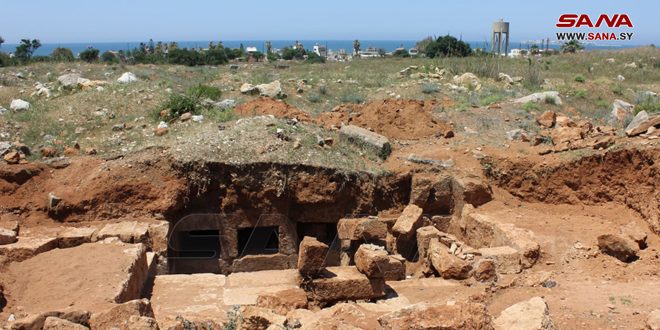 TARTOUS, May.26, (ST)- The joint excavation team between the General Directorate of Antiquities and Museums and the Tartus Department of Antiquities discovered during the excavation operations in the archaeological area of Amrit in Tartus a cemetery dating back to the Roman era and containing 19 tombs and staircases carved in rock, in addition to some archaeological finds and discoveries.
TARTOUS, May.26, (ST)- The joint excavation team between the General Directorate of Antiquities and Museums and the Tartus Department of Antiquities discovered during the excavation operations in the archaeological area of Amrit in Tartus a cemetery dating back to the Roman era and containing 19 tombs and staircases carved in rock, in addition to some archaeological finds and discoveries.
The Syrian Arab News Agency (SANA) quoted the Assistant Director-General of Antiquities and Museums, Hammam Saad, as saying that during the excavation operations at the site, it was noticed that there was an opening that later turned out to be the ceiling of the tomb.
Saad pointed out that the site was discovered earlier by excavations whose date cannot be defined, and they were carried out by unknown people who vandalized many of the remnant stones.
“After completing the cleaning and excavation work, the mission found two complete coffins that had been pulled from the cemetery by unknown people, in addition to broken coffins and bones and remnant glasses and pottery,” he added, indicating that Amrit is one of the important sites on the Syrian coast, and there is a plan to rehabilitate and open it to visitors.
For his part, the head of the Tartous Department of Antiquities, Marwan Hassan, made it clear that the cemetery is approximately 500 meters from the seashore, pointing out that the rehabilitation works and highlighting the archaeological finds in the city of Amrit are among the top priorities of the Directorate of Antiquities.
“Amrit site is one of the most important sites with its various components, which are distinguished by their distinctive characteristics, such as the stadium, the temple, the tower burials besides the multi-model burials,” he declared.
Hassan indicated that shedding light on Amrit’s importance at historical and civilizational levels is done by developing the necessary studies to rehabilitate some parts of the site and identifying paths to make visitors familiar with the history and importance of the area.
Basma Qaddour

